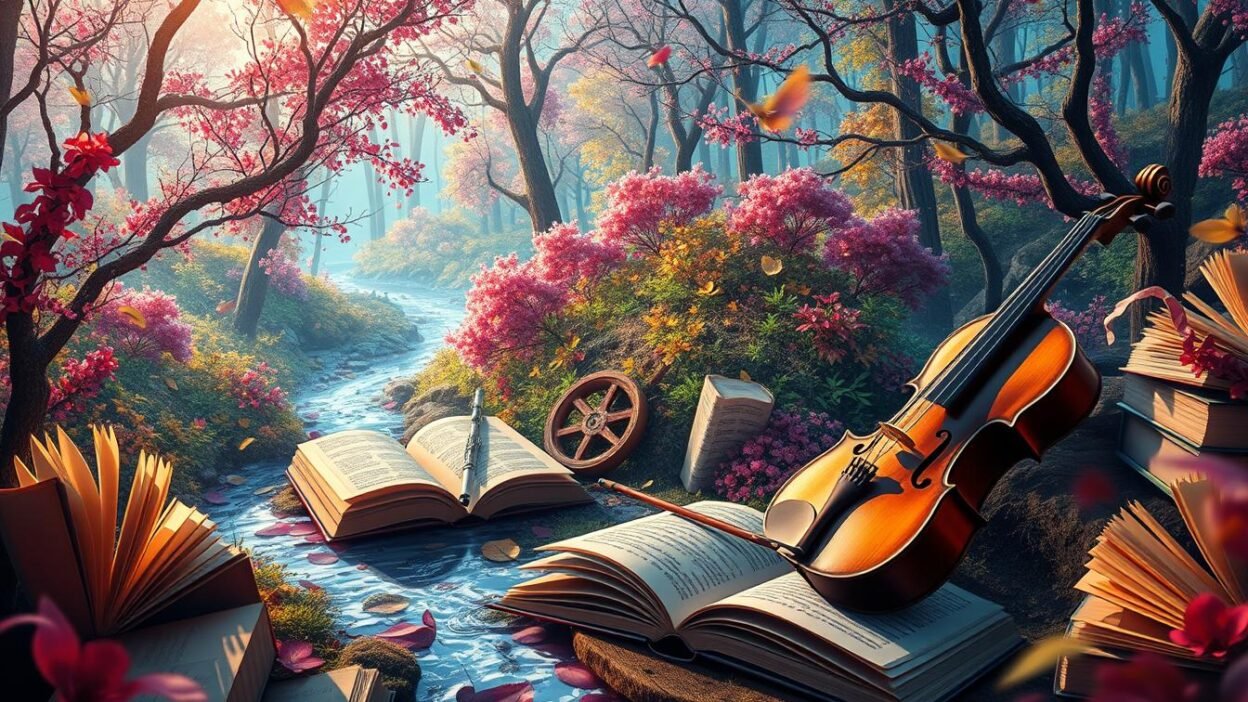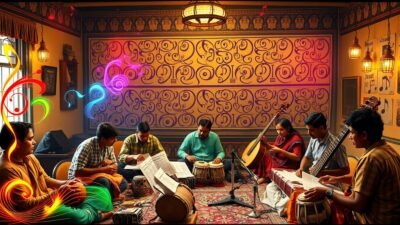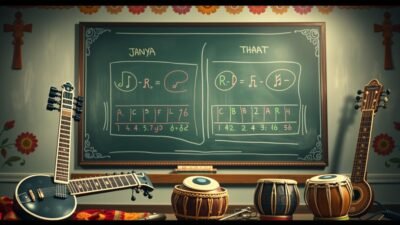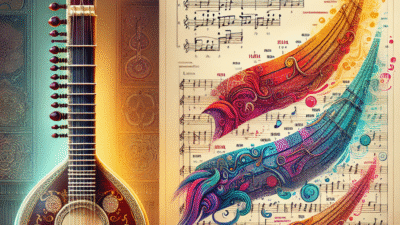Imagine if your favorite poem’s rhythm matches a classic song’s melody. Music and literature have a secret bond, influencing how stories are told and emotions are felt. This article shows how music’s rhythm and harmony shape literature’s meter and flow.
From ancient chants to modern novels, music and writing together create deeper feelings and creativity. This exploration reveals how they enhance our emotional connection and artistic expression.
Preparing for the UGC NET exam can be a daunting task, but with the right resources, candidates can navigate the process effectively. Websites like MyJRF provide a comprehensive platform for aspiring educators, offering specialized guidance for UGC NET Paper 2 preparation and essential tips for acing UGC NET Paper 1. Additionally, understanding the revised syllabus provided by UGC is crucial for a targeted study approach. For official announcements and updates, candidates should regularly visit the UGC NET NTA portal, while the UGC’s job section and the main UGC website are invaluable for post-exam opportunities and academic resources. With these tools, candidates can maximize their preparation and set themselves up for success. Preparing for Paper 1 and UGC NET Paper 2 Education requires a strategic approach with quality resources. UGC NET Education aspirants can access structured video lectures that cover essential concepts comprehensively. For an in-depth understanding, check out teaching aptitude videos and research aptitude guidance to strengthen your foundation. Additionally, higher education system topics and communication skills preparation are crucial for scoring high. Explore logical reasoning tutorials and mathematical reasoning lectures for better problem-solving skills. Enhance your exam strategy with people, development & environment lessons and ICT in education modules. For previous year papers and practice sessions, explore mock test videos and exam strategy tips. Stay ahead in your preparation with teaching methodology insights and subscribe to Educators Plus for expert guidance.
Key Takeaways
- Music and literature share foundational elements like rhythm, structure, and emotional appeal.
- Historical texts like the Rigveda and Beowulfused musical techniques to preserve oral traditions.
- Poetic meters directly mirror musical beats, influencing pacing and mood in written works.
- Modern authors and lyricists increasingly blend genres to create immersive storytelling.
- Understanding this interplay enhances both the appreciation and creation of art forms.
The Cultural Significance of Music in India
Music in India is more than just entertainment. It connects tradition and modernity. It shapes cultural identity through various music genres and practices. This section looks at its role in tradition, festivals, and cinema.
Traditional Genres and Their Influence
India’s classical music genres, Hindustani and Carnatic, are deeply rooted. Hindustani focuses on improvisation, while Carnatic has a fixed system. Folk music, like Baul’s mystic songs and Lavani’s lively tunes, shows the country’s cultural diversity.
These genres keep alive stories, teachings, and community values. They are a treasure trove of history and wisdom.
The Role of Music in Festivals
Festivals bring music to the forefront of community bonding. During Diwali, temples ring with devotional songs. Holi is filled with folk tunes like phag.
Specific ragas, like Raga Bhairav at dawn and Raga Malkauns at midnight, follow ancient theories. This shows music’s deep connection to rituals and the cosmos.
Connection to Bollywood Cinema
Bollywood music blends classical and modern styles. A.R. Rahman’s Sare Jahan Se Accha (1997) mixed patriotic poetry with orchestral music. Lata Mangeshkar’s songs turned lyrics into emotional stories.
Film music is a powerful tool for storytelling. It shapes public feelings and cultural discussions.
Literature’s Response to Musical Trends
Literature has always reflected the music industry in its own way. Authors turn musical trends into words, giving us a peek into their creative process. This shows how literature captures the essence of music and cultural changes.
Poetry Inspired by Music
Old Sanskrit poets like Kalidasa mixed ragas and tala into their poems. Later, Rabindranath Tagore changed how we see lyrics with his songs. Today, poets like Arundhati Subramaniam use rap and electronic beats to talk about our digital world.
This shows poetry’s ability to keep up with music:
- Raga-based meter systems in ancient texts
- Free-verse experiments mimicking jazz improvisation
- Social media poetry reflecting streaming culture
Prose Tales of Musicians
Books like A Suitable Boy (Mohan Rao) show the 1960s music world. They explore the politics of the music industry through fictional stories.
| Author | Work | Musical Focus |
|---|---|---|
| Vikram Seth | An Equal Music | String quartet dynamics |
| Chitra Banerjee Divakaruni | Palace of Illusions | Traditional devotional music’s socio-political role |
Soundtracks in Literary Narratives
Authors use music to set the scene and mood. Salman Rushdie’s Midnight’s Children uses Qawwali to mark the 1947 independence. This method:
- Brings the time period to life with specific sounds
- Helps us understand characters through their music tastes
- Uses melodies to solve conflicts
This shows how literature keeps music alive and critiques the music industry.
The Emotional Impact of Music on Readers
Authors and composers aim to shape emotions. They use music in writing to create deep feelings. This section looks at how writing and music production work together to affect our minds.
Music as a Tool for Mood Setting
Setting moods in writing is like arranging music. Short sentences can create tension, like staccato rhythms. Long, flowing sentences can feel warm, like a string quartet.
Recurring themes in writing are like musical motifs. They tie to characters and add depth to stories.
- Changing the pace of a story is like shifting music’s tempo
- Repeating phrases is like a musical loop, strengthening emotions
Creating Imagery Through Sound
Using sound metaphors in writing lets readers see sounds. Saying “the room vibrated with unspoken conflict” makes us feel like we hear dissonant chords. This connection between text and sound is like music production’s use of spatial audio.
“Language’s auditory dimensions engage the brain’s auditory cortex, proving text can simulate sound perception,” stated neuroaesthetic studies analyzing cross-modal sensory engagement.
The Psychology of Music in Literature
Reading about music can make our brains respond like we’re hearing it. Key psychological factors include:
- Emotional contagion: Minor keys in writing can make us feel sad
- Memory linkage: Musical references in writing connect to our personal experiences, making stories more emotional
Authors use structure to guide readers through emotional journeys. This shows how writing can mimic the power of music.
Historical Context: Music and Literature Through Ages
Music and literature have been connected for thousands of years. They have shaped our culture and art. This section looks at important moments when they came together, showing how society’s changes affected them.
Ancient Texts and Musical References
Early societies put music in their sacred and everyday texts. For example, the Rigveda was sung with rhythm. Greek tragedies, like those by Euripides, had music played on the lyre.
Medieval times saw the Book of Psalms with chants that mixed song and prayer.
The Renaissance and Musical Revival
The Renaissance brought back love for ancient times, leading to new ideas. Composers like Palestrina mixed music with Latin texts. Poets, like Petrarch, wrote sonnets that followed musical patterns.
Shakespeare’s plays, like Twelfth Night, used songs to highlight themes. This time showed a cultural awakening through art.
Modern Literature’s Musical Quotients
In the 20th century, writers started using music in their work. Think about:
- F. Scott Fitzgerald’s The Great Gatsby with jazz rhythms
- Virginia Woolf’s writing that flows like music
- Authors like Toni Morrison using blues to show feelings
Today, books are written like songs or operas. This shows music’s lasting impact on literature.
From ancient times to now, music has helped literature tell our stories.
Cross-Genre Inspirations: Music and Literature
Modern literature often focuses on music, mixing stories with sound in new ways. Novels, biographies, and poetry collections lead this trend. They show how music influences storytelling today.
Novels with Musical Themes
Books like Donna Tartt’s The Goldfinch weave classical music into their stories. The main character’s love for a painting is like J.S. Bach’s fugues. Today, writers use Spotify playlists to add real music to their stories.
This makes it easier for authors to include different music styles. From Carnatic ragas to indie rock, it’s all possible.
Music Biographies in the Literary World
Books about musicians, like Patti Smith’s Just Kids, blend facts with poetry. Streaming services help biographers find rare music. This adds depth to their stories.
The key is to keep the story true while making it poetic.
Poetry Collections Dedicated to Music
Poets like Tracy K. Smith (Life on Mars) turn music into words. They use rhythms and structures found in music. Here are three examples:
| Collection | Author | Musical Focus |
|---|---|---|
| Notes on a Scandal | Tracy K. Smith | Jazz improvisation |
| Raga No. 1 | Jeet Thayil | Indian classical traditions |
| Verse and Chord | Alexander Theroux | 20th-century avant-garde |
Today, poets use music streaming to find sounds and styles. Jeet Thayil, for example, explores Indian classical music. This shows how literature and music are connected in new ways.
The Interactions Between Musical and Literary Arts
Musicians and writers team up to break new ground in creativity. They mix deep stories with sounds, creating something new. For example, Vikram Seth’s poetry and Vanraj Bhatia’s music together make feelings stronger. This shows how working together can make both arts better.
Collaborations Between Musicians and Writers
- Novelist Chitra Banerjee Divakaruni teamed up with composer Reena Esmail. They mixed Indian folk tales with music.
- Poet and musician Ravi Shankar wrote a book and made music. His stories and songs show off cultural richness.
- The Mumbai Literary Festival now has songwriting sessions. This brings writers and musicians together for inspiration.
Music as a Medium for Storytelling
Zubin Mehta turned Premchand’s novels into music. He used special melodies for each character. This is like how authors use hints and clues in their stories.
Nusrat Fateh Ali Khan made Sufi poems into songs. He turned deep thoughts into rhythms. This shows music can tell stories, thoughts, and endings without words.
Events that Celebrate Both Art Forms
The Jaipur Literature Festival now has music during talks. The Kolkata Book Fair has music with author readings. These events show how music and writing can talk to each other.
Gayatri Spivak said:
“Interdisciplinary platforms dissolve the myth of separate ‘high’ and ‘low’ arts.”
These music events help people see both arts as part of a whole, not separate.
The Evolution of Lyrics and Poetry
Lyrics and poetry have always been connected, influenced by culture and music genres. From ancient chants to today’s rap, lyrics fit the melody while keeping their literary value. This section explores their evolution through history, debates, and regional differences.
Historical Development of Song Lyrics
Early lyrics were tied to rituals and work. In Europe, troubadours and in South Asia, sufi qawwalis, showed how lyrics reflected society. By the 20th century, jazz and rock focused on personal stories over strict rhythms. Key moments include:
- 12th century troubadour trobar clus (esoteric wordplay)
- Mughal-era ghazals blending Urdu poetry with classical music genres
- 20th-century protest songs merging free verse with folk rhythms
Lyricists as Poets
Many question if song lyrics are poetry. Critics like Robert von Hallberg say rhythm and rhyme limit complexity. But Rabindranath Tagore and Leonard Cohen show lyrics can be deep. Scholars now study lyrics as texts, using formalism and intertextuality.
Regional Variations in Songwriting
India’s many languages lead to unique lyrics. Tamil carnatic songs focus on devotion, while Punjabi Bhangra uses everyday language for dances. These styles show:
- Bengali adhunik poetry’s deep stories
- Kannada devarnama devotional lyrics
- North Indian ghazals keeping Persian rhyme schemes
This variety highlights how music genres influence lyrics. From Marathi Lavani’s feminist verses to Assamese bihu songs celebrating harvests, each region has its own style.
Music as a Narrative Device in Fiction
Music in literature is more than just background. It shapes characters, moves plots, and evokes emotions. It turns sound into a powerful tool for storytelling. This section looks at how music adds depth to stories.
Building Character through Musical Talent
A character’s love for music shows their inner self. In The Soloist by Steve Lopez, a musician’s skills show his mental state. When characters make music, it shows their creativity, discipline, or pain.
A character’s skill in music can tell a lot about them. For example, a sitar player might show their cultural roots or personal battles. Music is a quick way to understand a character’s story.
Music in Plot Development
Music can change the story’s direction. In The Song of Achilles, a song starts important alliances. Key moments include:
- A symphony rehearsal exposing hidden rivalries
- A protest anthem sparking rebellion
- A failed raga performance triggering a character’s downfall
These scenes use music’s power to raise the stakes and show the outcome.
Creating Tension and Release with Sound
Authors use music’s ups and downs in their stories. In Bel Canto, opera performances contrast with tense situations. This mirrors music’s structure, with tension and release.
Unresolved chords or off-key notes build tension. But, big music performance scenes bring relief. They match the story’s end with musical harmony.
The Role of Music in Shaping Identity
Music is a big part of who we are, both as individuals and as groups. It shapes how we see ourselves and our communities. Books often explore this connection, showing how music reflects our memories and growth.
Music and Personal Narratives
Books like Notes from a Small Island by Bill Bryson show how music marks important moments in our lives. Characters in The God of Small Things by Arundhati Roy use music to find their way through tough times. It becomes a personal anthem for them.
Collective Identity Through Music
“Music is the universal language of mankind.”—Henry Longfellow
Stories like Ramayana and folk music from places like Punjab show how music brings people together. Books like Samskara by U.R. Ananthamurthy show how hymns and chants keep cultures strong, even when things are tough.
Regional vs. Global Influences
The music industry shows the mix of local and global sounds. For example, Qissa: The Tale of a Lonely Goat shows how global pop meets local folk. A 2023 UNESCO report found that 68% of Indian youth mix Bollywood with classical music, as seen in Narcopolis by Jeet Thayil.
| Category | Regional Example | Global Influence |
|---|---|---|
| Instrumentation | Sitar in Rabindra Sangeet | Electronic beats in modern Bhangra |
| Themes | Seasonal harvest songs | Global protest anthems |
| Literary Portrayal | Ruskin Bond’s Himalayan folk tales | Chimamanda Ngozi Adichie’s Americanah (Nigerian hip-hop’s diasporic themes) |
From old folk songs to today’s playlists, music guides us in finding ourselves. It’s a key part of understanding ourselves and our world through stories.
The Influence of Digital Platforms on Music Literature
Advances in music technology have changed how literature and sound meet. Digital platforms are now places where stories and music come together. This changes how we create and experience art.
E-books and Music Integration
Publishers are adding audio to e-books. This lets readers hear music as they read. For example, Penguin Random House has interactive editions of books like *The Song of Achilles*. These editions come with playlists for key scenes.
This mix of music and text makes stories more emotional and clear.
Social Media as a Marketing Tool
Instagram and Twitter help authors and musicians work together. Authors write lyrical texts, and musicians share songs. This has led to more projects combining words and music.
A 2023 study found a 40% increase in collaborations in India. Hashtags like #LitSound help build communities around these projects.
Streaming Services and Literary Collaboration
Spotify and other streaming services team up with publishers. They create playlists that match the mood of books. For example, a thriller might come out with a playlist that fits its atmosphere.
But, these playlists might only play popular music. This could limit the range of stories told through music.
“Algorithmic systems favor what’s familiar but also open up new music-literature combinations,” said Dr. Rajeshwar Mehta, a digital media researcher at IIT Bombay.
- E-books with musical scores (e.g., Audible’s *Symphony of Shadows*)
- Social media challenges like #VerseAndChords for fan content
- Spotify’s “Novel to Notes” program pairing authors with composers
Music technology opens up new creative paths. But, we must be careful not to lose the original message. This balance is what makes the digital world exciting for literature and music.
Case Studies of Prominent Author-Musicians
Artists who excel in both music and literature break down barriers between disciplines. Their skill in both areas shows how mixing creativity can boost artistic expression. These examples look at how these artists blend sound and text, shaping today’s music education and teaching methods.
Iconic Figures Who Embrace Both Art Forms
- Rabindranath Tagore: First Asian Nobel laureate, composed 2,000+ songs and poems. His work combines Bengali folk tunes with literary themes, showing cultural fusion.
- Bob Dylan: Nobel Prize-winning lyricist whose folk songs mirror modernist poetry, changing how stories are told across mediums.
- Leonard Cohen: Novelist and singer-songwriter, his albums like Book of Longing turn poetic images into musical tales.
- Patti Smith: Known as the “punk poet laureate,” she mixes spoken word with rock, inspiring new forms of interdisciplinary art.
The Unique Voice of Musician-Writers
These creators use techniques from both worlds. Dylan’s rhymes echo epic poetry, while Tagore’s ragas guide the emotional flow of his verses. Cohen’s use of minor chords in songs like “Hallelujah” mirrors the depth of his novels. This blending shows how music training improves storytelling and lyrical skill.
The Legacy of Their Dual Contributions
Now, academic programs use their works to teach music education and literary analysis. Places like Rabindra Bharati University use Tagore’s work to show how music tells stories. Dylan’s Nobel win sparked discussions on the value of lyrics in literature. Their legacies show that combining disciplines leads to innovation, encouraging educators to mix creative practices in their teaching.
“Art is not a decor but a fundamental necessity of life,” Rabindranath Tagore
These pioneers challenge old academic boundaries, showing that mastering multiple mediums boosts both artistic and teaching results.
Future Trends: The Convergence of Music and Literature
The world of music and literature is changing fast. Soon, we might see less of a line between these two art forms. New ways of telling stories through sound and words will change how we enjoy art together.
Emerging Genres and Styles
Audio dramas are becoming popular, mixing spoken stories with music. Albums like Taylor Swift’s Folklore mix music with storytelling. Even texts and sounds made by AI are changing how we see genres.
The Role of Technology in Art Evolution
Virtual reality (VR) is creating new ways to experience stories. AI tools like OpenAI’s Muse help make music that fits the story. Interactive stories, like those with Spotify playlists, let you choose what happens next.
In India, music streaming services are adding literary playlists. This shows a move towards more sensory experiences.
Predictions for the Next Generation of Artists
Future artists will likely learn both music and writing. Schools like IIT Bombay are starting programs for this. Music streaming services want to offer more immersive content.
Hybrid works, like stories in podcasts, might become more common. But, finding ways to make money and keep art true to itself will be a challenge. Yet, combining music and writing could lead to exciting new stories, inspired by India’s rich traditions.





